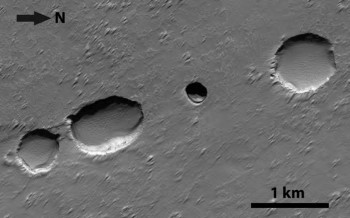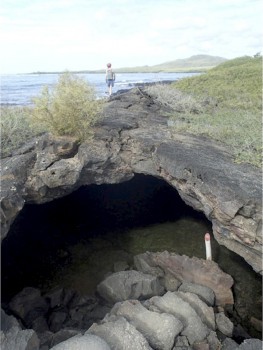
A typical overcrusted lava tube on the northern side of Arsia Mons in the Tharsis volcanic province of Mars. The dark circle are skylights open on the underground conduit. (credits NASA/JPL/University of Arizona)
There are thousands of kilometers of unexplored caves on Earth. But speleologists are wondering if planets such as Mars could have cave systems as well. And our imagination runs… How big could they be? How long are they? In science fiction novels and movies extraterrestrial caves are huge galleries even spaceships can fly through. They often host monstrous creatures, as shown in films such as Star Wars, Dune or more recently Prometeus. The reason why underground caverns are so inspiring to the imagination is easily explained: we know almost nothing about them. They are the dark side of the planet’s in the Solar System.
Most observations of Mars have come from orbiters and rovers that can only see the surface. We have very little information on what could be underground. In 2018 the InSight lander mission to Mars will use a sophisticated instrument to investigate the depths of the Red Planet and the next rover planned by NASA for 2020 will have a new generation of ground penetrating radar (called RIMFAX) that will investigate some dozens of meters below the surface. Several studies are evaluating use of caves as shelters for the first human mission to the Red Planet, planned for 2030.
Mars has huge volcanoes, one order of magnitude bigger than on Earth: Olympus Mons reaches the impressive height of 21 kilometers while the whole region of the Tharsis volcanic bulge covers a surface of over 25 million square kilometers. The most probable type of caves that we will find will be related to volcanic processes. Just in 1969, a research team from NASA guided by Verne Oberbeck, suggested that some peculiar features, named “sinuous rills”, observed on the lava fields of Moon and Mars, could have been related to collapses of lava tubes, a peculiar type of volcanic cave well known by volcanologists. Lava tubes form on Earth when low-viscosity lava flows develop a continuous and hard crust which thickens and forms a roof above the still-flowing lava stream. When the eruptions end, the conduit is drained leaving a tubular conduit beneath the surface. More complex and deep tubes can also form because of inflation of lava between previous flows: the fluid pressure of the lava opens a conduit that can leave a huge maze of empty veins.
Thanks to direct exploration by speleologists, we have a lot of information about lava tubes on Earth. Speleologists produced detailed morphological descriptions and topographic surveys of up to 65 km long on tubes on Hawaii, Iceland, North Queensland in, Australia, Sicily, Galapagos in Ecuador and many others.
But what we can say about lava tubes on Mars? We do not have satellites able to observe below the surface of the Red Planet so the only features that we can detect are potential entrances, the so-called “skylights”. These are wide holes, collapses and deep shafts that are open to the surface giving access to this underground world. Actually some tens of skylights have been found on the Martian volcanoes. Most of them are related to sinuous elongated depressions called pit craters that could be sections of a lava tube that has collapsed. Skylights and pit craters are generally some hundreds of meters wide. By analyzing the shadow projected by shaft’s borders on interior walls we can also get an idea of its minimum depth, which in some cases is more than 100 meters. In the shield volcano Arsia Mons, sinuous lines of skylights and pit craters can be followed for more than 50 km to the outflow channels were the lava emerged.
A recent study of these skylights (lead by researchers of the Italian universities of Bologna and Padova) compared them to ones of Earth and has given us clues about the real origin and dimension of these potential caves.
The data obtained from the survey of a lava tubes in Hawaii revealed that the depth and width of the collapses is directly related to the size of the lava tube in a linear relationship. This relationship is also supposed for Martian lava tubes. The depth and width of the largest Martian collapses implies a diameter of the tube that could be up to two orders of magnitude larger than terrestrial ones. This means that on Mars we could find underground counduits 100s of meters in diameter. The huge size of the Martian structures is probably connected to the Martian environment (gravity, thin atmosphere, surface temperature) and eruption types (higher effusion rates, thicker lava flows), but also to emplacement mechanisms such as channeled events of inflation along existing tubes or subsequent entrenchment of the same conduit during different flow phases.
However huge lava tubes are probably not the only type of caves on the planet. In recent years planetary geologists discovered that extensive areas of Mars are characterised by soluble lithologies such as sulphates. The surface of Mars is an arid and rough environment with no liquid water, but in the past (mostly in the “Hesperian” period, more than 3 billions years ago) the planet probably had oceans and underground aquifers. In that time soluble lithologies were affected by deep solutional weathering and large cave systems could have occured. Evidence of this kind of process was found in sulphate terrains and diapirs in the Arabia Terra region, with exactly the same forms that we can find on Earth: cave entrances, doline-like depressions and sinkholes.

A skylight in between two atypical pit craters on the southern flanks of Arsia Mons. The skylight is around two hundred meters wide and 80 meters deep. (credits NASA/JPL/University of Arizona)
But why is research on caves and their exploration on Mars so important? The most important point is related to the search of extraterrestrial life. Caves can host water deposits that cannot form on the surface and the interaction between water, volcanic heat and peculiar minerals such as sulphates could have created an environment favorable to the preservation and evolution of microbial life.
In addition caves are important for the future of Mars exploration because they could provide shelter from the harsh surface conditions. Caves represent unique environments, shielded from cosmic radiation, and with a less daily temperature fluctations and are therefore potential candidates for human settlements.
And who knows? Maybe the first human on the Red Planet will have to combine the skills of astronaut and speleologist. Two parallel journeys of exploration will then join to be one.
Francesco Sauro
CAVES technical instructor
Read more:
Lunar Pits Could Shelter Astronauts, Reveal Details of How ‘Man in the Moon’ Formed
From Earth’s Caves – A Better Understanding of Mars
Candidate cave entrances on Mars
Lunar and Martian Lava Tube Exploration as Part of an Overall Scientific Survey


Discussion: no comments